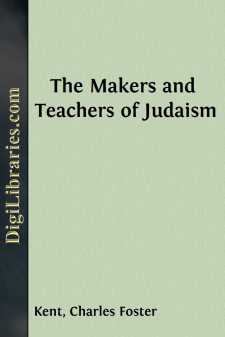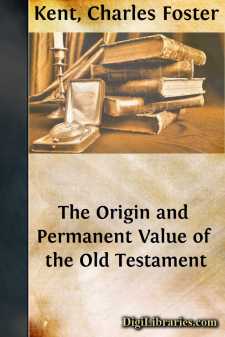Categories
- Antiques & Collectibles 13
- Architecture 36
- Art 48
- Bibles 22
- Biography & Autobiography 813
- Body, Mind & Spirit 142
- Business & Economics 28
- Children's Books 16
- Children's Fiction 13
- Computers 4
- Cooking 94
- Crafts & Hobbies 4
- Drama 346
- Education 46
- Family & Relationships 57
- Fiction 11829
- Games 19
- Gardening 17
- Health & Fitness 34
- History 1377
- House & Home 1
- Humor 147
- Juvenile Fiction 1873
- Juvenile Nonfiction 202
- Language Arts & Disciplines 88
- Law 16
- Literary Collections 686
- Literary Criticism 179
- Mathematics 13
- Medical 41
- Music 40
- Nature 179
- Non-Classifiable 1768
- Performing Arts 7
- Periodicals 1453
- Philosophy 64
- Photography 2
- Poetry 896
- Political Science 203
- Psychology 42
- Reference 154
- Religion 513
- Science 126
- Self-Help 84
- Social Science 81
- Sports & Recreation 34
- Study Aids 3
- Technology & Engineering 59
- Transportation 23
- Travel 463
- True Crime 29
The Makers and Teachers of Judaism
Description:
Excerpt
VIII. The Temple of Yahu at Elephantine. These Aramaic legal documents also contain many references to Yahu (the older form of Yahweh or Jehovah), the god worshipped by the Jews, and to Yahu's temple situated on King's Street, one of the main thoroughfares of the city. These references have been signally confirmed by a most remarkable letter recently discovered by the Germans at this site. It was written in November of the year 408 B.C., by the members of the Jewish colony at Elephantine to Bagohi (the Bagoas of Josephus), the Persian governor of Judah. It states, among other things, that "Already in the days of the kings of Egypt our fathers had built this temple in the fortress of Elephantine. And when Cambyses (529-522 B.C.) entered Egypt he found this temple built, and, though the temple of the gods of Egypt were all at that time overthrown, no one injured anything in this temple." It further states that recently (in the year 411 B.C.), in the absence of the Persian governor in Egypt, the foreigners in Elephantine had stirred up a certain minor official to instruct his son, who was commander of a neighboring fortress, to destroy the Jewish temple.
The Aramaic letter was intended to be sent, together with rich gifts, to influence the powerful Persian governor of Judah, Bagohi, to issue an order permitting the Jews to rebuild their temple. From this letter we learn that the temple of the God Yahu was built of hewn stone with pillars of stone in front, probably similar to those in the Egyptian temples, and had seven great gates built of hewn stone and provided with doors and bronze hinges. Its roof was wholly of cedar wood, probably brought from the distant Lebanon, and its walls appear to have been ceiled or adorned with stucco, as were those of Solomon's temple. It was also equipped with bowls of gold and silver and the other paraphernalia of sacrifice. Here were regularly offered cereal-offerings, burnt-offerings, and frankincense. The petitioners also promised that, if the Persian officials would grant their request, "we will also offer cereal-offerings and frankincense and burnt-offerings on the altar in your name, and we will pray to God in your name, we and our wives and all the Jews who are here, if you do thus until the temple is built. And you shall have a portion before the God Yahu, the God of Heaven, from every one who offers to him burnt-offerings and sacrifices."
Historical students have long been familiar with the fact that late in the Greek period the Jews of Egypt built a temple to Jehovah at Leontopolis, in the Delta (cf. Section CXV:iii); but these recent discoveries open an entirely new chapter in Jewish history. They indicate that probably within a generation after the destruction of the Jerusalem temple, in 586 B.C., the Jewish colonists in Egypt built for themselves far up the Nile, and possibly at other points in this land of their exile, a temple or temples to Jehovah; that they remained loyal to God and the institutions of their race; and that in the midst of cosmopolitan Egypt they preserved intact their racial unity. In the light of these discoveries it is also clear that because of their character and numbers and nearness to Palestine the Jews of Egypt, even at this early period, were a far more important factor in the life and development of Judaism than they have hitherto been considered. These discoveries also afford definite grounds for the hope that from this unexpected quarter much more valuable material will come to illumine this otherwise dark period of post-exilic Jewish history.
Section XCII. EZEKIEL'S MESSAGE TO HIS SCATTERED COUNTRYMEN
[Sidenote: Ezek. 37:1-6] The hand of Jehovah was upon me, and he brought me by the spirit and set me down in the midst of the valley; and it was full of bones. And he caused me to pass by them round about; and, behold, there were very many on the surface of the valley; and, lo, they were very dry. And he said to me, Son of man, can these bones live? And I answered, O Lord Jehovah, thou knowest. Again he said to me, Prophesy over these bones, and say to them, O ye dry bones, hear the word of Jehovah. 'Thus saith Jehovah to these bones: "Behold I am about to put breath into you, that ye may live....



